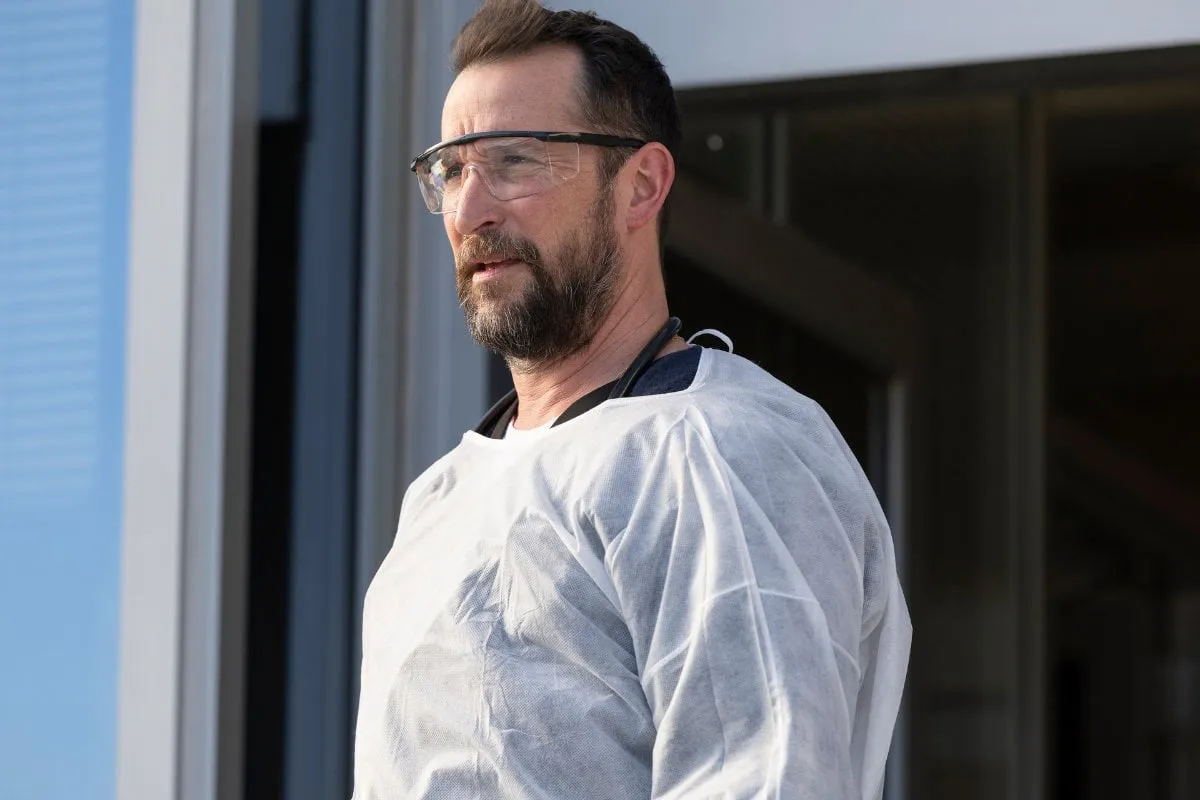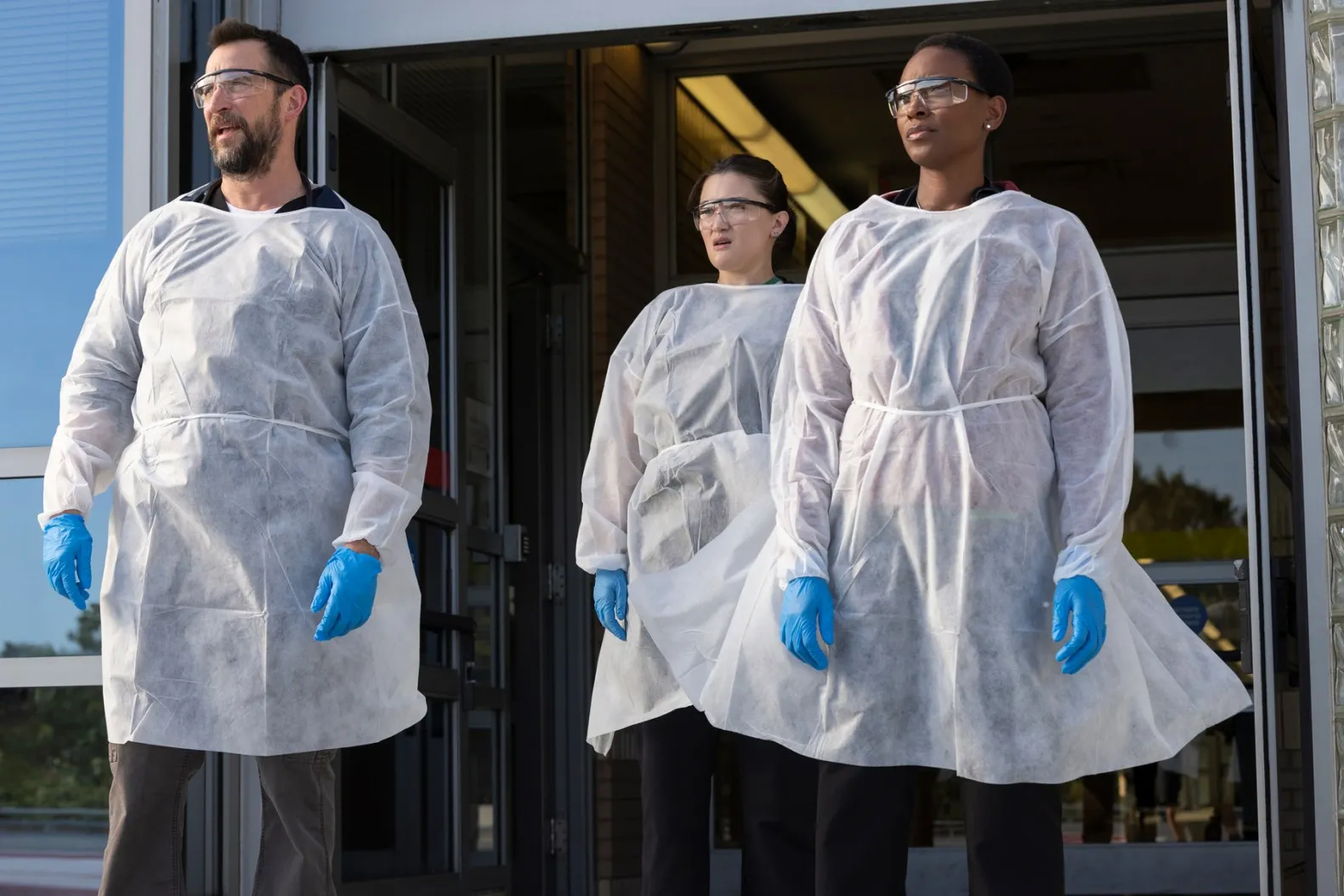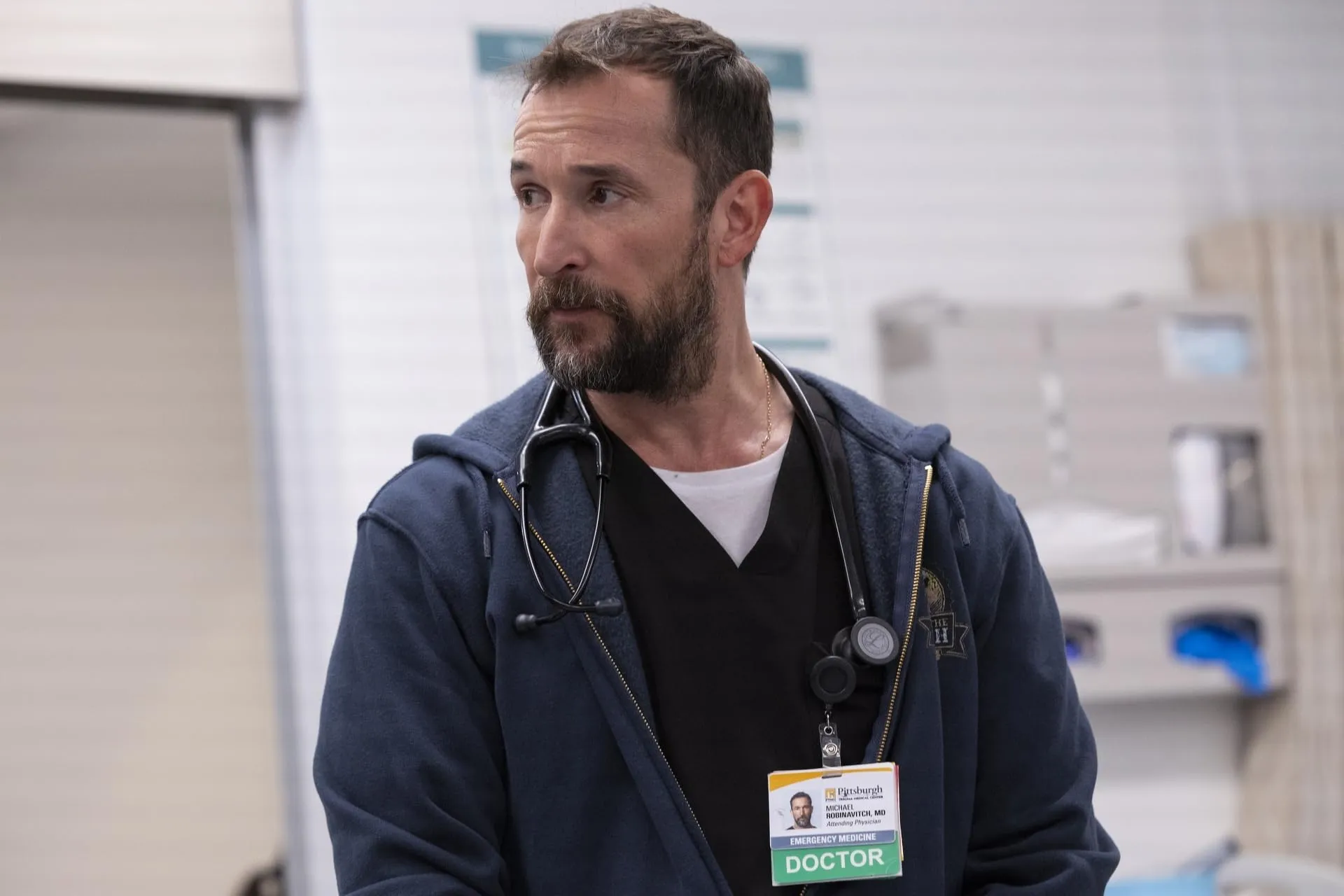The Pittsburgh Trauma Medical Center is more than just a background in “The Pitt,” but also a lively character in and of itself, reflecting how chaotic and interesting modern healthcare can be. A lot is going on, and lives are little in balance.
The way this character is portrayed hits home with viewers, especially during the COVID-19 pandemic, making us all understand the stress that field workers are under. Still, the show’s portrayal of Pittsburgh seems strangely disconnected; besides a few nods to the city, it mostly feels like a generic medical drama rather than a story set in a real place.
A single, intense fifteen-hour shift, akin to “24,” is the series’ real-time narrative framework. This method increases the sense of urgency and pulls viewers into the fast-paced chaos of emergency medicine. While the format aims to create immediacy, it sometimes sacrifices character development and depth, reflecting a growing trend in streaming series that prioritizes pace over nuance.
“The Pitt” exemplifies a move toward storytelling that is as relentless as the emergency room itself, pushing the limits of how we engage with narrative lines in a time when binge-watching has become the norm.
Navigating Chaos: Character Analysis in “The Pitt”
The return of Dr. Michael “Robby” Robinavitch to the world of medical drama is both a nod to the past and a study in complexity, and it is at the center of “The Pitt.” Robby is a character who feels the weight of loss and duty. He is driven by the memory of his mentor’s death at the height of the COVID-19 pandemic.
This backstory gives the story more emotional depth and helps us understand sadness and endurance. Wyle shows Robby’s dual nature, where his need to protect others often clashes with his emotional instability.
Robby is surrounded by a group of different residents who help him. Each one represents a different aspect of modern medical care and the challenges that come with it. Collins (Tracy Ifeachor), a pregnant resident struggling with her personal life and work goals, adds more complexity.
Langdon, played by Patrick Ball, adds humor and wit to the show and challenges the more serious characters. Then there’s Mohan (Supriya Ganesh), whose caring personality contrasts her problems with structural problems like racial inequality in healthcare. The narrative is enhanced by the diversity of experiences within the medical field, and each character brings a different viewpoint.
The characters’ interactions with one another are very telling; they switch between being friendly and having tension, reflecting the high-stress environment of the emergency room. The exchanges show a hierarchy based on experience and emotional labor, with more experienced staff members often being asked to teach less experienced staff members what they need to know. This connection reflects larger societal themes like mentoring, privilege, and the hidden burdens that people in power carry.
The characters’ pasts are also integrated into the story, affecting their choices and relationships. The societal pressures that shape healthcare workers today are also discussed in these narratives, which help to develop the characters. “The Pitt” becomes a mirror reflecting the complexities of modern medical practice and the diverse human experiences that inhabit it as viewers watch how trauma, ambition, and interpersonal conflict clash.
The Heartbeat of “The Pitt”: Themes and Messages
By diving right into the murky seas of modern healthcare, “The Pitt” paints a vivid picture of the systemic problems that plague the medical field today. The urgent problems of understaffing and hospital privatization, which are not shown as faraway problems but as immediate crises affecting both patients and providers, are at the heart of its narrative.
The show successfully dramatizes these themes through the chaotic setting of the Pittsburgh Trauma Medical Center, where a constant flow of patients shows the flaws in an already overworked system. This place serves as a microcosm of larger societal challenges, reflecting a healthcare system that frequently puts money before people, forcing medical workers and patients to wade through a maze of red tape and emotional stress.
The characters’ problems add to these themes in the studies. The backstory of each resident is intricately woven into the larger narrative, showing how their unique experiences shape how they deal with the relentless demands of their jobs. For instance, Dr. Robby Robinavitch’s haunting memories of loss during the pandemic are not just a plot device; they are a symbol of the group trauma that healthcare workers experience. This weaving together of personal past and professional duty makes a complex tapestry that shows how long-term stress and emotional exhaustion in the medical field hurt people.
Additionally, the show isn’t afraid of addressing the complexities of identity and privilege in the healthcare system. Characters like Mohan and Collins deal with their challenges, reflecting the interplay of race, gender, and socioeconomic status in healthcare settings. This complex portrayal makes viewers think about the struggles these characters face on an individual level and how those struggles reflect bigger societal problems.
“The Pitt” engages with these themes while challenging traditional storytelling formats by choosing a real-time narrative that stresses urgency. This decision reflects the fast-paced, high-stakes nature of emergency medicine and supports the idea that medical workers must deal with their own weaknesses while trying to save others’ lives. By doing this, the series not only entertains viewers but also starts important discussions about the realities of modern healthcare, making it an important addition to the growing body of television storytelling.
Capturing Chaos: Production Quality in “The Pitt”
A notable aspect of “The Pitt” that greatly enhances its storytelling and pulls viewers into the hectic world of emergency care is its production quality. To create a sense of chaos and immediacy, the style is characterized by dynamic cinematography that uses handheld cameras and tight framing.
The audience is drawn into the emotional turmoil that the characters experience through this method, which also mimics the hectic environment of a busy trauma center. The use of space is especially effective; the emergency room’s bright, open plan contrasts sharply with the huge influx of patients, creating an environment where life-or-death decisions are made under relentless pressure.
The pacing of “The Pitt,” which is directed by John Wells, is relentless and interesting. Wells is known for his skill with large ensemble groups and intricate narratives. Wells expertly juggles scenes of high tension with quieter, introspective ones, giving the reader a break from the chaos for a short while. This rhythm is essential in a series to accurately capture the experience of a single, intense shift occurring in real time. The choices made during editing add to the sense of urgency; quick cuts and overlapping dialogue create the noise of an emergency room while keeping the narrative coherent.
The depth of character growth is questioned despite the commendable technical execution. Does the fast-paced style overpower the individual stories, making complicated characters seem like they’re just in a race against time? This tension between form and content compels viewers to think about how stories are told and what is most important in them. While “The Pitt” tries to find this fine line, it also shows a bigger trend in streaming TV: a focus on visual spectacle that can make character depth less important in favor of style.
Performance Highlights in “The Pitt”: A Study in Depth and Nuance
Noah Wyle’s return to TV as Dr. Michael “Robby” Robinavitch is a powerful reminder of how well he can capture the complexity of characters. Wyle skillfully navigates the emotional terrain of a doctor dealing with loss and guilt, giving a performance that hits home with viewers. In the pilot episode, Robby is dealing with the anniversary of the death of his mentor.
Wyle shows a range of feelings, from sadness and guilt to a strong desire to care for his patients. In Episode 4, where he helps siblings deal with the loss of their father, his complex portrayal is especially evident. In this scene, Wyle’s skill at showing both weakness and strength shines, telling audiences of the heavy load that healthcare workers carry while performing their relentless tasks.
The supporting cast enriches this emotional tapestry with standout performances that add to the narrative. Tracy Ifeachor’s performance as Dr. Collins is a moving look into the problems women in medicine face, especially as she tries to balance her career goals with her pregnancy. She has a strong character arc, especially in scenes where she has to deal with the challenges of having two parts simultaneously. These scenes make you feel both sympathy and admiration for her.
With his sharp wit and snark, Patrick Ball, as Dr. Langdon, pairs Robby’s emotional depth with humor, adding a sense of balance to the chaos. A scene where Langdon handles a problem with humor beautifully shows this dynamic and shows how humor can help people deal with high-pressure situations.
In addition, Supriya Ganesh’s Dr. Mohan makes pointed comments about racial differences in healthcare, especially when her character fights for patients while dealing with her problems. These layers of representation not only reflect problems in society right now but also question how medical shows have traditionally shown things.
Together, these acts make a rich ensemble that reflects healthcare’s complexity by highlighting individual struggles and the group’s strengths. As “The Pitt” progresses, it becomes evident that the series’ strength lies not just in its narrative but also in the powerful performances that bring its themes to life, making the show an important addition to the changing landscape of television storytelling.
A Legacy Reexamined: Comparative Analysis of “The Pitt”
“The Pitt” clearly connects to its predecessor, “ER.” Noah Wyle’s return is both a nod to the past and a critical look at the medical drama genre. The tone and narrative approach of “The Pitt” differs from that of “ER,” despite both shows being about the crazy chaos of emergency care.
“The Pitt” relies too much on a real-time format emphasizing chaos and urgency, often at the cost of deep character exploration. “ER” did a great job balancing melodrama with touching moments of humanity. This style mirrors current streaming storytelling trends, where immediacy and pacing can precede character development, creating different emotional engagement.
In the world of medical shows today, “The Pitt” stands out specially. While still trying to be entertaining, it exposes the harsh realities of modern healthcare issues like understaffing, privatization, and racial disparities. Its readiness to face these issues head-on makes it a possible sign for future series in the genre, indicating that audiences are ready for stories that reflect the complexities of contemporary medical practice.
“The Pitt” not only pays tribute to “ER” by doing this, but it also makes its way, which could affect how future medical dramas find the right mix between show and substance in a field that is getting increasingly crowded.
Overall Impact and Audience Reception: Navigating the Pulse of “The Pitt”
“The Pitt” has carved out a unique niche in the crowded field of medical dramas by addressing the complicated realities of healthcare in a post-pandemic world. Not only does the series engage viewers with its fast-paced, real-time narrative, but it also brings up important moral and emotional issues.
Audiences are encouraged to reflect on their relationships with healthcare systems as the characters deal with their personal problems and professional obligations. How can we help the people whose job is to save lives while also looking closely at a system that often seems broken? The contrast between the two characters makes for an interesting dialogue that engages viewers on many levels.
Issues like understaffing, systemic injustices, and the emotional toll on healthcare workers are prominent in the series, which does not shy away from the uncomfortable facts about modern healthcare. The time for this honest look is right now when people are more aware of differences in healthcare. “The Pitt” challenges conventional narratives that frequently sanitize or romanticize the medical field by showing how different characters deal with these difficulties. Instead, it gives an unfiltered, raw perspective that speaks to people with direct experience with the system’s realities.
The societal significance of “The Pitt” lies in how it depicts healthcare and how it might affect future storytelling in the genre. The series shows how medical dramas can change to reflect societal changes by dealing with real-life problems. Whether through advocacy, education, or a better understanding of the healthcare landscape, viewers may wonder how they can engage with these themes outside the screen. “The Pitt” challenges audiences to think critically about the systems that shape their lives, possibly impacting viewers and the genre.
The Review
The Pitt
"The Pitt" successfully combines emotional realities with urgent social commentary to capture the confusing depth of modern healthcare. While the diverse ensemble adds authenticity to the narrative, Noah Wyle's powerful performance is the series' anchor. The show challenges medical drama conventions and engages viewers by addressing systemic problems head-on. The overall impact is big, even though its real-time format sometimes affects character growth. "The Pitt" is a genre-defining entry that paves the way for future storytelling.
PROS
- Strong acting, particularly from Noah Wyle and the supporting cast.
- Engages with contemporary healthcare issues, such as understaffing and systemic inequities.
- Creates a sense of urgency and immersion, reflecting the chaos of emergency medicine.
- Features a varied cast that brings authenticity to the characters' experiences.
CONS
- The fast-paced format can overshadow deeper character arcs.
- Balancing humor and drama may occasionally feel uneven.
- The real-time structure might confuse viewers unfamiliar with the format.



















































